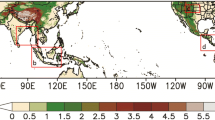Abstract.
This work describes the formulation and climatology of an atmospheric general circulation model (GCM) of intermediate complexity, based on a spectral primitive-equation dynamical core and a set of simplified physical parametrization schemes. The parametrization package has been specially designed to work in models with just a few vertical levels, and is based on the same physical principles adopted in the schemes of state-of-the art GCMs. The parametrized processes include large-scale condensation, convection, clouds, short-wave and long-wave radiation, surface fluxes and vertical diffusion. In the current configuration, the model (nicknamed SPEEDY, from Simplified Parametrizations, primitivE-Equation DYnamics") has five vertical levels and a spectral truncation at total wave number 30 (T30L5). The top vertical level (crudely) represents the stratosphere, the bottom one the planetary boundary layer. Computationally, SPEEDY requires (at least) one order of magnitude less CPU time than a state-of-the-art GCM at the same horizontal resolution, and is therefore suitable for studies of inter-decadal or inter-centennial variability. Statistics of the model mean state and variability are computed from an ensemble of 41-year simulations forced by observed sea-surface temperatures in the period 1952–1992. The model mean state is closer to the observed climatology during the (boreal) winter than during summer. In winter (i.e. December to February, DJF), the model underestimates the amplitude of the Northern Hemisphere stationary wave pattern, particularly in the European-Atlantic sector. Some aspects of the systematic error of SPEEDY are in fact typical of many GCMs, although the error amplitude is stronger than in state-of-the-art models. On the other hand, the global distribution of precipitation in DJF is quite realistic, and compares well with that of more complex GCMs. In summer (June to August), a strong negative bias in the mid-tropospheric temperature generates a Northern Hemisphere circulation with some springtime characteristics. In particular, the position of the Tropical Convergence Zone in the Indian Ocean remains too far south, leading to a deficient simulation of the monsoon circulation over South Asia. The simulated variability during the northern winter is reasonably realistic as far as the spatial distribution is concerned, although some underestimation in the intensity can be found, particularly in the low-frequency range and in the Atlantic sector. The atmospheric response to ENSO events is also weaker than observed, although the spatial patterns of the rainfall and geopotential response in the Pacific sector are in phase with their observed counterparts. In the Atlantic/Eurasian region, the spatial patterns associated with the interdecadal trends in the simulated and observed large-scale circulation show a clear positive correlation, consistent with the hypothesis of a positive ocean–atmosphere feedback on decadal time scales.
Similar content being viewed by others
Author information
Authors and Affiliations
Additional information
Electronic Publication
Rights and permissions
About this article
Cite this article
Molteni, .F. Atmospheric simulations using a GCM with simplified physical parametrizations. I: model climatology and variability in multi-decadal experiments. Climate Dynamics 20, 175–191 (2003). https://doi.org/10.1007/s00382-002-0268-2
Received:
Accepted:
Issue Date:
DOI: https://doi.org/10.1007/s00382-002-0268-2




